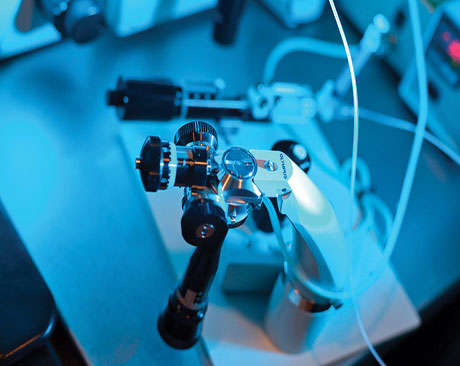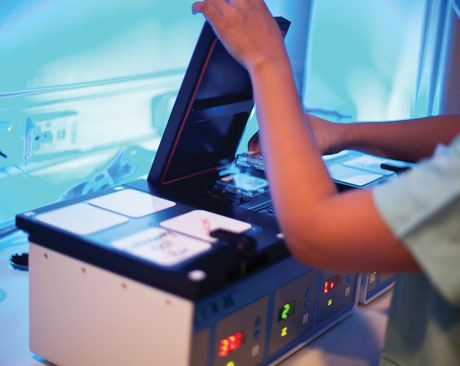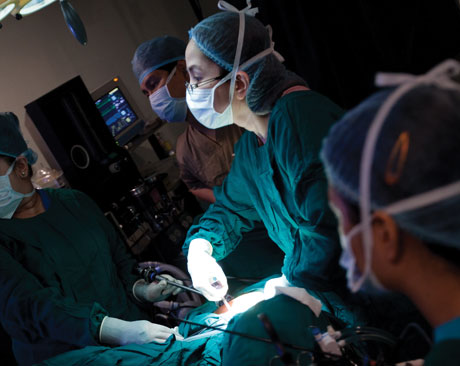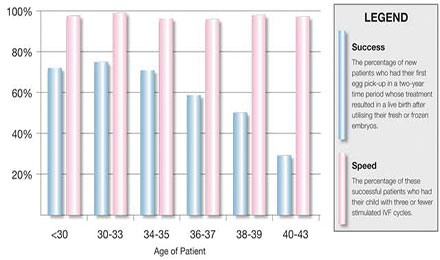


Patient Resources
What is Infertility?
Infertility is clinically defined as the inability to produce offspring after 1 year of regular unprotected intercourse.
Infertility is not uncommon. It affects 10 to 15% of couples of reproductive age.
How do I know I'm Infertile?
More and more women have been seeking consultation for various reproductive concerns, but the paramount question is usually whether she is indeed capable of childbearing.
Although there is a standard definition for infertility, you are at high risk if you have the following: advanced maternal age, pelvic inflammatory disease, endometriosis, polycystic ovarian syndrome, high-stress occupation, stressful environment, smoking habits, drug toxicity, excessive exercise, inadequate nutrition and extreme weight change.
The female factor is responsible for 47.6% of infertility. The male factor contributes to 19.5%. A combination of both factors makes up 17. 5%. Unknown causes contribute 9.7% and other factors are responsible for 5.7% of cases.
One does not rush to the conclusion that she is infertile. All patients need a thorough and expert assessment of overall health and reproductive chances. This is done step by step, starting with a consultation and then usually followed by a series of laboratory tests to support the doctor's impression.
Infertility is a diagnosis that is a result of thorough examination and analysis. We advise you to consult a doctor with specialized training in reproductive medicine before you conclude that you are infertile. It is a multidisciplinary approach. The team at Repro Optima is comprised of the very best in the field, backed by an international team of consultants. Click here for a consultation
What happens if I am diagnosed with infertility?
If indeed you are diagnosed with infertility, you are then given the options that are appropriate for your condition. Every woman is free to choose whether or not to undergo treatment.
Infertility is not an easy condition to accept for many. However, modern technology offers hope. There is now an unprecedented range of options available for those with this condition.
Your Options
If you do select a procedure, you are entitled to be fully informed of the treatment method of your choosing. Be mindful of the risks, success rates and the limitations of the procedure.
Repro Optima is known for its wide range of reproductive treatments and highly successful outcomes. Learn more
Depending on the cause of your condition, we will be able to recommend the best course of treatment for you. Contact us now
Our Commitment of Confidentiality
We take this opportunity to assure you of the highest ethical standards when it comes to your medical records and your visits with us. Rest assured that Repro Optima will keep all details of your diagnosis and treatment highly confidential.
Think you might be Infertile?
Male infertility has become a matter of rising concern. As more and more couples in this modern age are having reproductive problems, people are asking how much of those cases are attributable to men.
Infertility is clinically defined as the inability to produce offspring after 1 year of regular unprotected intercourse. The male factor is attributable to 19.5% of the causes of infertility.
How Do I know I'm Infertile?
Infertility is never an easy diagnosis to accept. With men, there are many issues that go beyond biological concerns. Male factor infertility is categorized into mild, moderate and severe.
Oligospermia, asthenospermia and terato-zoospermia are the common clinical conditions among men that are associated with increased risk of infertility. To diagnose any of these, you must undergo a thorough clinical assessment. Repro Optima provides complete reproductive health management for couples.
Our Commitment to Confidentiality
Rest assured that Repro Optima keeps all details of your diagnosis and treatment confidential.
Infertility involves the couple; both male and female should be worked-up. You may have to undergo the following laboratory examinations:
Basic Tests
- Transvaginal ultrasound (part of the physical exam in infertility patients)
- Semen analysis
- Hysterosalpingogram (fluoroscopic)
- Test for evidence of ovulation: mid-luteal phase serum progesterone
Supplemental Tests
- Hormone assays
- FSH, LH, estradiol, TSH, prolactin, testosterone, etc.
- Special sperm function tests
- Trial wash
- Anti-sperm antibody test
- Diagnostic laparoscopy/hysteroscopy when pelvic, peritoneal, tubal, endometrial disease is highly entertained

Intrauterine insemination
Intrauterine Insemination (IUI) is the process by which sperm is deposited in a woman's uterus through artificial means. Sperm used in IUI must first be properly prepared. This process is known as sperm washing. How well and proper the sperm you are using in your procedure is prepared can influence the chances of success with this procedure. That is why it is important for you to have the procedure done in a credible institution such as Repro Optima, which is highly specialized in fertility procedures.
After sperm washing, a catheter is used to place a number of washed sperm directly into the uterus. The goal of IUI is to increase the number of sperm that reach the fallopian tubes and subsequently increase the chance of fertilization.
Because IUI still requires the sperm to reach and fertilize the egg on its own, it is important to make sure that the sperm is healthy and motile. IUI provides the sperm an advantage by giving it a head start, but it still has to seek out the egg on its own.
In Vitro Fertilisation
In Vitro Fertilisation (IVF) is a process by which egg cells are fertilised by sperm outside the body, in vitro. IVF is a major treatment in infertility. The process involves hormonally controlling the ovulatory process to induce the production of more than one oocyte (egg). This is followed by removing oocytes from the woman's ovaries and letting sperm fertilise them in a fluid medium in the laboratory. The fertilised egg (zygote) is then observed further as they grow into embryos. Some of these embryos are then transferred to the patient's uterus with the intent to establish a successful pregnancy. The other embryos undergo cryofreezing to be used in the future for frozen embryo transfer.
Intracytoplasmic Sperm Injection
Intracytoplasmic sperm injection (ICSI), pronounced "eeksee", is an in vitro fertilization procedure in which a single sperm is injected directly into an egg.
This procedure is most commonly used to overcome male infertility problems, although it may also be used in cases where eggs cannot easily be penetrated by sperm, and occasionally as a method of in vitro fertilization, especially that associated with sperm donation.
It can be used in teratozoospermia. Even with severe teratozoospermia, microscopy can still detect the few sperm cells that have a "normal" morphology, allowing for optimal success rate.
Testicular Sperm Extraction
Testicular Sperm Extraction (TESE) is the process of removing a small portion of tissue from the testicle under local anesthesia and extracting the few viable sperm cells present in that tissue for the purpose of intracytoplasmic sperm injection (ICSI). The testicular sperm extraction process is recommended to men who are unable to produce sperm by ejaculation as a result azoospermia, such as caused by primary testicular failure, congenital absence of the vas deferens or non-reconstructed vasectomy.
Intracytoplasmic sperm injection (ICSI) and testicular sperm extraction (TESE) have reduced the need for donor sperm.
Laparoscopy and Hysteroscopy
A complete examination of a woman's internal pelvic structures can provide important information regarding infertility and common gynecologic disorders. Frequently, problems that cannot be discovered by an external physical examination can be discovered by laparoscopy and hysteroscopy, two procedures which provide a direct look at the pelvic organs. These procedures may be recommended as part of your infertility care, depending on your particular situation. Laparoscopy and hysteroscopy can be used for both diagnostic (looking only) and operative (looking and treating) purposes.
Diagnostic laparoscopy may be recommended to look at the outside of the uterus, fallopian tubes, ovaries, and internal pelvic area.
Diagnostic hysteroscopy is used to look inside the uterine cavity. If an abnormal condition is detected during the diagnostic procedure, operative laparoscopy or operative hysteroscopy can often be performed to correct it at the same time, avoiding the need for a second surgery. Both diagnostic and operative procedures should be performed by physicians with surgical expertise in these areas. The following information will help patients know what to expect before undergoing any of these procedures.
Diagnostic Laparoscopy
Laparoscopy can help physicians diagnose many gynecological problems including endometriosis, uterine fibroids and other structural abnormalities, ovarian cysts, adhesions (scar tissue), and ectopic pregnancy. If you have pain, history of past pelvic infection, or symptoms suggestive of pelvic disease, your physician may recommend this procedure as part of your evaluation. Laparoscopy is sometimes recommended after completing an initial infertility evaluation on both partners. It is usually performed soon after menstruation ends. Laparoscopy is usually performed on an outpatient basis under general anesthesia. After the patient is under general anesthesia, a needle is inserted through the navel and the abdomen is filled with carbon 3dioxide gas. The gas pushes the internal organs away from the abdominal wall so that the laparoscope can be placed safely into the abdominal cavity to decrease the risk of injury to surrounding organs such as the bowel, bladder, and blood vessels. The laparoscope is then inserted through an incision in the navel. Occasionally, alternate sites may be used for the insertion of the laparoscope based upon physician experience or the patient's prior surgical or medical history. While looking through the laparoscope, the physician can see the reproductive organs including the uterus, fallopian tubes, and ovaries. A small probe is usually inserted through another incision above the pubic region in order to move the pelvic organs into clear view. Additionally, a solution containing blue dye is often injected through the cervix, uterus, and fallopian tubes to determine if they are open. If no abnormalities are noted at this time, one or two stitches close the incisions. If defects or abnormalities are discovered, diagnostic laparoscopy can become operative laparoscopy.
Operative Laparoscopy
During operative laparoscopy, many abdominal disorders can be treated safely through the laparoscope at the same time that the diagnosis is made. When performing operative laparoscopy, the physician inserts additional instruments such as probes, scissors, grasping instruments, biopsy forceps, electrosurgical or laser instruments, and suture materials through two or three additional incisions. Lasers, while a significant help in certain surgeries, are expensive and are not necessarily better or more effective than other surgical techniques used during operative laparoscopy. The choice of technique and instrumentation depends on many factors including the physician's experience, location of the problem, and availability of equipment. Some problems that can be corrected with operative laparoscopy include removing adhesions from around the fallopian tubes and ovaries, opening blocked tubes, removing ovarian cysts, and treating ectopic pregnancy. Endometriosis can also be removed or ablated from the outside of the uterus, ovaries, or peritoneum. Under certain circumstances, fibroids on the uterus can also be removed. Operative laparoscopy can also be used to remove diseased ovaries and can assist in the performance of hysterectomy.